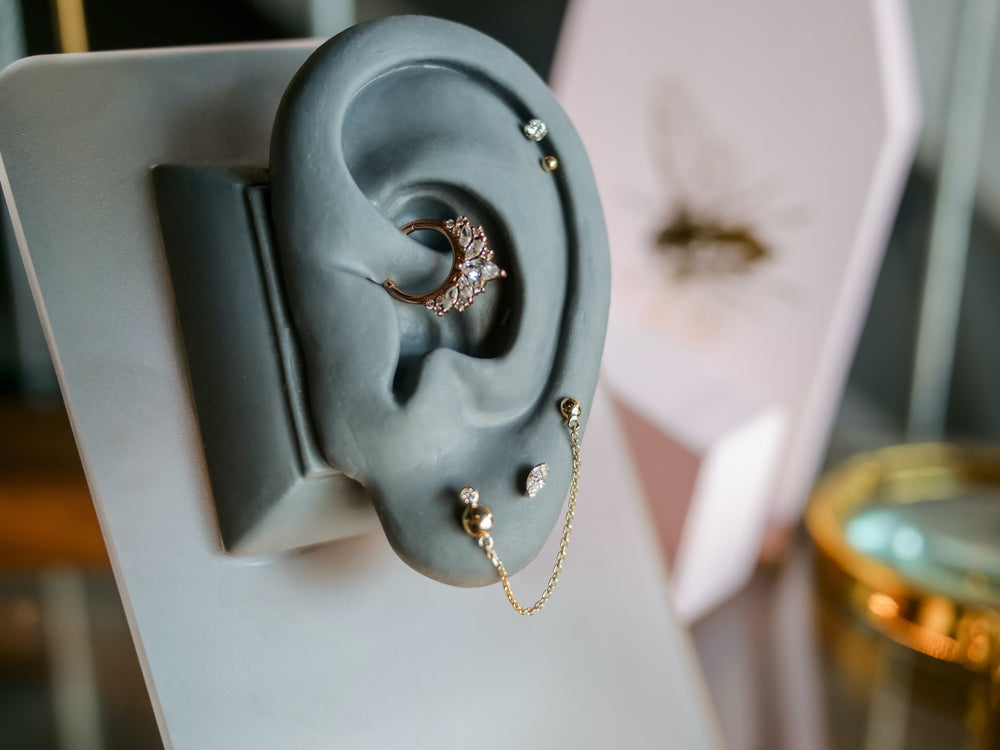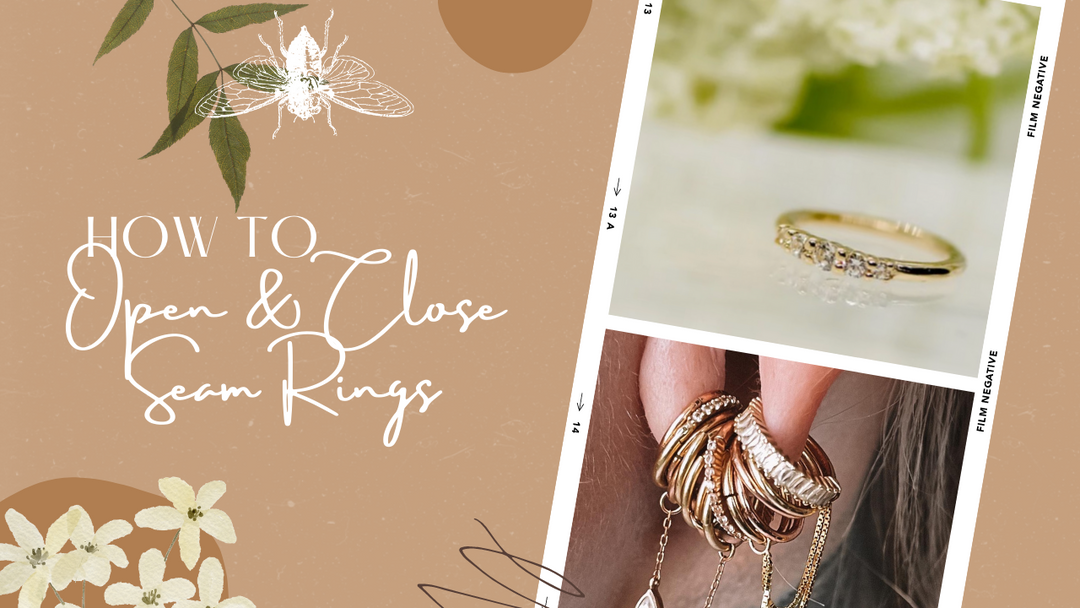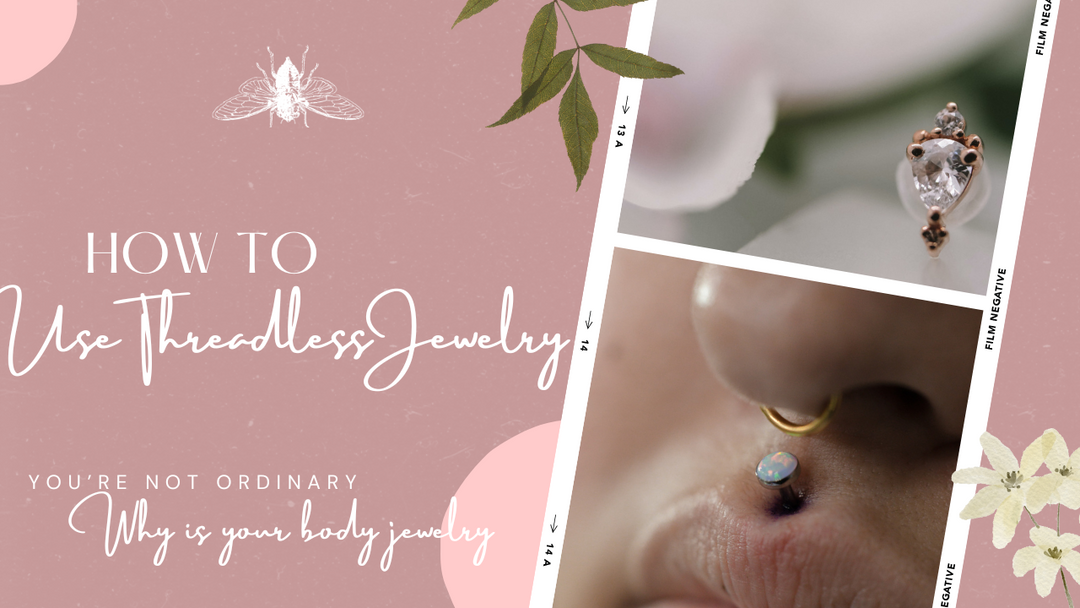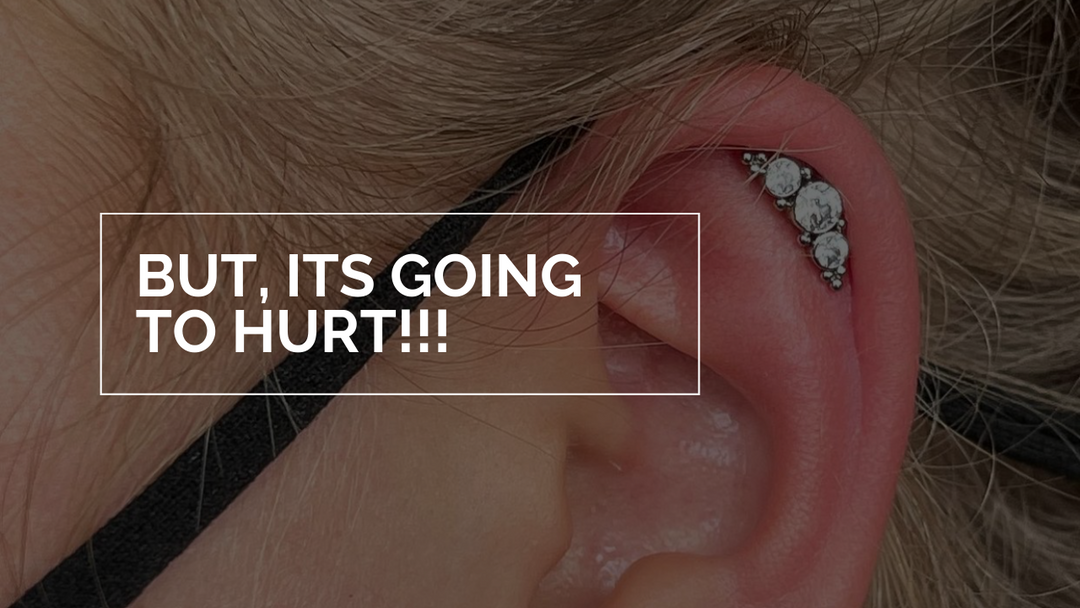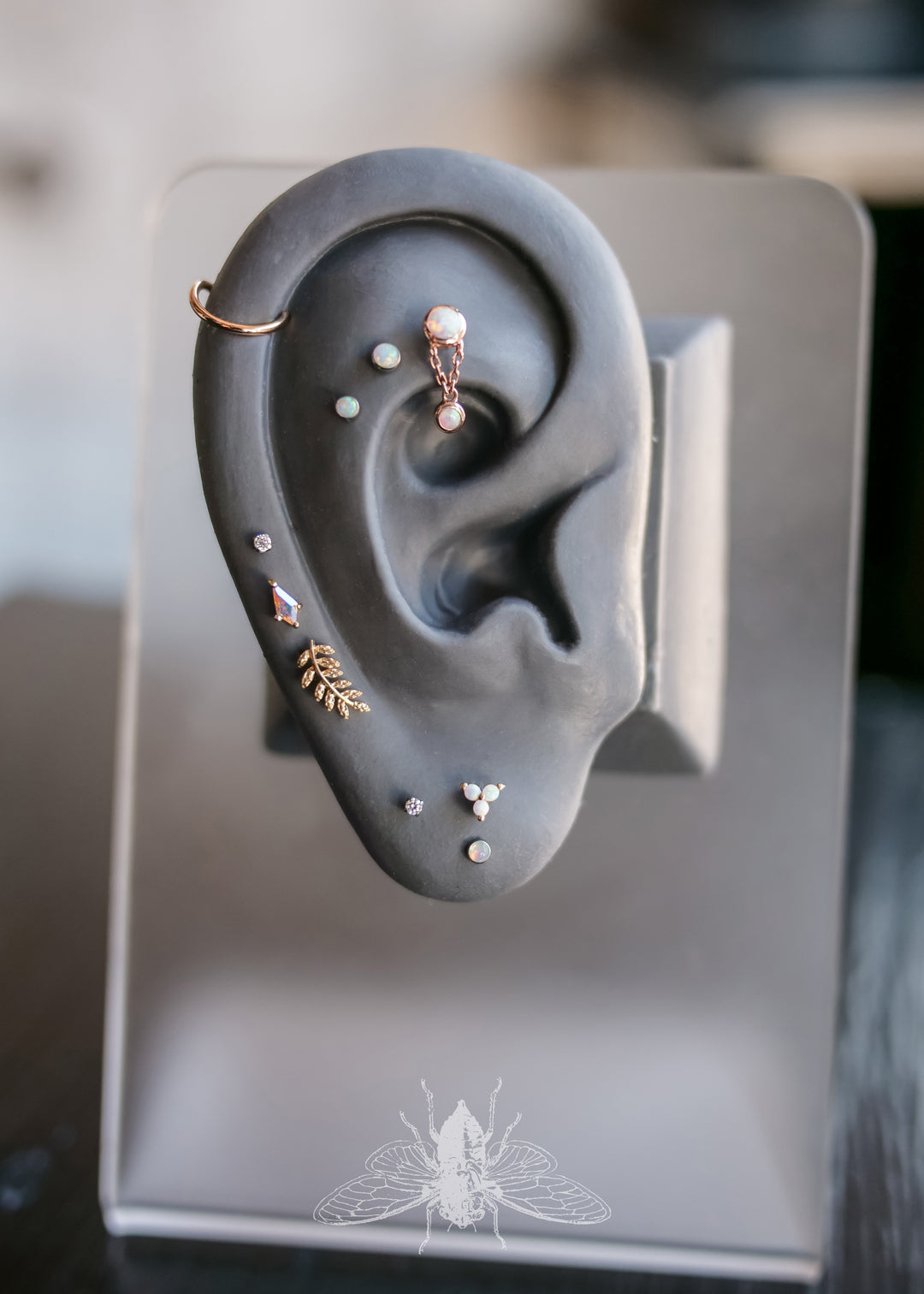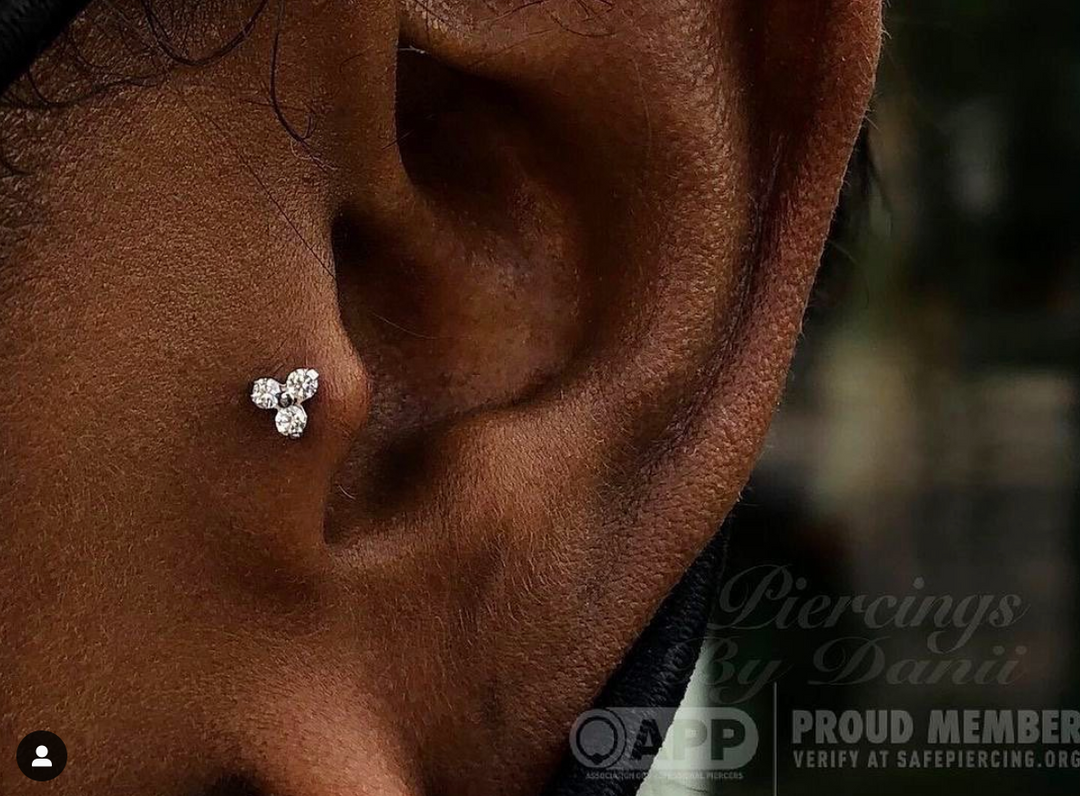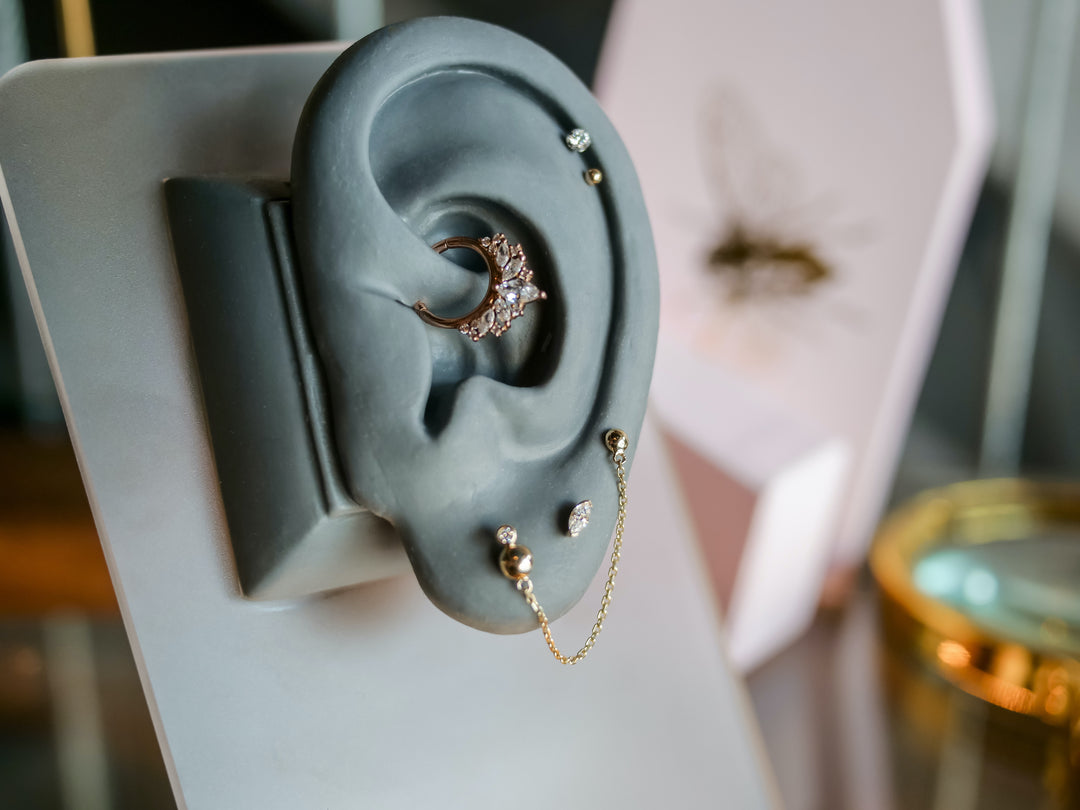If you discover you have a complication with your piercing, the first thing to do is not panic, contact the piercer who did the piercing and let them recommend the best course of action. If this does not work, consulting a doctor is the next step. Do NOT Google your symptoms, do NOT call another piercer in the area as you will more than likely not receive accurate information and will be more inclined to panic or remove a piercing that can be healed easily.
Most importantly - DO NOT REMOVE THE JEWELRY. We can not stress that enough. Removing the jewelry in the case of an infection will cause the infection to become trapped under the skin and thus worsen.
If you develop a fever, contact your doctor immediately.
In almost all cases, the complication is harmless and easy to treat, we have compiled a list of common complications, how to identify them and how we recommend treating them. We do not recommend following these instructions without consulting your piercer first.
Keloids are a very large, dense mound of scar tissue that becomes bigger than your original piercing. They can be extremely unsightly and can grow extremely rapidly to enormous sizes. Unfortunately, once you have formed a keloid, you will never completely remove it without surgery. We highly recommend avoiding getting piercings - specifically in cartilage type areas if you have a family history of keloids.
Hypertrophic Scars are a scar that sits above the surface of the skin. They are quite small and rather common. Hypertrophic scarring sometimes goes away spontaneously, or it may recur and recede in cycles for an extended period of time before improving substantially or disappearing.
Both Keloids and Hypertrophic Scars are more likely to develop on areas like cartilage, on darker skin types, people prone to scarring or after a trauma or due to movement and friction in the area (sleeping on the piercing, playing with it, getting it caught on hair etc), however there is no way to guarantee you won’t get them and no way to prevent or predict them.
Identifying Hypertrophic Scarring
• Raised fleshy bump surrounding a piercing that stays within the bounds of the piercing
• Usually somewhat pink or red in color, at least initially
• Not tender; may itch
• Tends to form during the healing period
• No pus or other drainage
Identifying Keloids
• Large, disproportionate to the size of the piercing, by at least twice the size
• Sometimes tender, painful, or itchy
• Usually red or hyper-pigmented and vascular
• Can develop over many months, or even up to a year following the piercing
To Treat Hypertrophic Scars - we recommend speaking to your piercer and following their recommendations or a Sea Salt Compress.
Sea Salt + Water Soak/Compress
◦ Add 1/4 teaspoon of sea salt to one cup of boiling water. Stir until the salt is completely dissolved.
◦ When the salt water has cooled slightly (you want it to be as hot as possible without burning your skin), dip a clean cotton pad into the cup.
◦ Hold the soaked cotton pad against the bump for two minutes. Do NOT take your jewelry out, avoid pulling or pushing it around.
◦ Repeat the salt soak twice a day until the bump has disappeared.
Some people recommend adding Chamomile tea to their salt soak as this can soothe the inflammation.
Others report Tea Tree oil to help reduce keloids.
Piercing Pimples are a very common and yet relatively unknown complication, they are basically excess oil and dirt that has formed in/around your piercing, basically like a giant pore. They are easy to remove however can reoccur indefinitely and at any time for no rhyme or reason.
Identifying a Piercing Pimple
• Small, slightly elevated pus-filled bump or pimple adjacent to the piercing
• Red and inflamed, but contained locally
• May be tender, itch, or burn, though some are painless
• Usually secretes pus and/or blood when drained (or popped)
To Treat Piercing Pimples - we recommend speaking to your piercer and following their recommendations or a Sea Salt Compress.
Sea Salt + Water Soak/Compress
◦ Add 1/4 teaspoon of sea salt to one cup of boiling water. Stir until the salt is completely dissolved.
◦ When the salt water has cooled slightly (you want it to be as hot as possible without burning your skin), dip a clean cotton pad into the cup.
◦ Hold the soaked cotton pad against the bump for two minutes. Do NOT take your jewelry out, avoid pulling or pushing it around.
◦ Repeat the salt soak twice a day until the bump has disappeared.
You can pop these the same way you pop a pimple - we do not recommend this but if you do have one pop, drain all the pus and fluids out like you would with a pimple, and clean with the above sea salt soak.
Dry Skin is an extremely common reaction after a piercing. We recommend contacting your piercer and letting them know how you are cleaning the piercing and how often. More than likely, you are over cleaning the wound and causing the skin to become dry. Try reducing how often you clean the piercing to once a day or reducing the amount of sea salt in your mixture (1/8 teaspoon to one cup water). Avoid using regular soaps, body washes or shampoos on the piercing, and do not apply lotions or perfumes to the area. You can also try to use a dye and fragrance free laundry detergent.
Contact Dermatitis is a skin rash caused by an allergen or irritant. This is most likely from low quality jewelry or harsh soaps, disinfectants and cleansers. If you have gone to a quality piercer - please remember that you were pierced with sterile equipment and as long as you follow the aftercare instructions and clean the piercing as recommended, you do not need to disinfect the wound.
Many people are sensitive to nickel, a metal found in most body jewelry. Surgical grade Stainless Steel or .316 may contain up to 5% nickel and most people will not have a reaction to this material. If you do have a reaction to .316 Surgical Steel, we recommend Titanium or Niobium, although normally twice the price of Surgical Steel they contain no nickel and are completely safe.
We do not recommend other types of metal for initial piercings aside from Surgical Grade Stainless Steel, Titanium, Gold or more uncommonly Niobium. You can also try more flexible materials like PTFE or Bioflex.
Identifying Dermatitis
• Redness, rash (blisters, multiple pimple-like eruptions, or hives), and inflammation; sometimes cracking, flaking, or peeling skin follow the initial outbreak
• Localized swelling, tenderness, and possible warmth
• Oozing clear fluid
• Itching and possibly burning
• The hole of your healing piercing becomes visibly larger than the jewelry in it
To Treat Dermatitis
Do not use anything other than Saline Solutions or Sea Salt to clean your piercings, Avoid harsh chemicals, scented products, products with any dyes, disinfectants such as alcohol, Dettol, Hydrogen Peroxide etc.
Ask your piercer to change your jewelry to a higher quality material. Avoid Gold, .925 sterling silver, plated metals etc.
If your itching is severe, try a non topical anti-histamine like Benedryl for allergies.
Embedded Jewelry is rather uncommon and is easily prevented with a little bit of attention to your piercing. If you are pierced with or put in jewelry that is too small, it can become embedded in the skin.
If this is happening due to swelling after the initial piercing - do not panic. Take 2 anti-inflammatory pills every 4 hours - generic Ibuprofen is the most effective. The swelling should subside in 12hours. If you notice the piercing pulling in during this period, wash your fingers and gently push the piercing free from the wound. This may be uncomfortable or painful but will prevent the jewelry from becoming embedded.
If this happens overnight, it may require a more forceful push to remove the jewelry from the wound.
This type of reaction is extremely common in nipple piercings and nostril piercings with studs.
If the swelling does NOT recede in 12 hours, contact your piercer and go get them to change the jewelry to a longer piece.
Oral piercers like lip and tongue piercings nest in the tissue during healing, this is normal, lightly push them free and move them periodically. If your piercing has gone into your skin more than 1/4 inch - contact your piercer.
In the event that the tissue completely grows over the jewelry and you or your piercer cannot push it back through the surface, you must seek medical attention as soon as possible.
Hyper-Granulation Tissue or Benign (Non-Cancerous) Growths are most commonly from some type of trauma to a wound, they can also come from having excessive moisture in the wound or after an infection.
This type of complication may require medical treatment in the form of medication and may take longer periods of time to heal. They are more common in areas like the nostril, navel, labia, or lip (more naturally moist or damp areas)
Identifying Hypergranulation Tissue
• Raised bump coming out of the skin
• Looks like raw tissue or hamburger meat
• Oozing clear or yellow sticky drainage
• Bleeds often
To treat these growths we recommend trying to keep the piercing dry, reduce activities that cause friction to the area and Sea Salt Soaks, Topical application of rubbing alcohol, 3 percent hydrogen peroxide, iodine or undiluted tea tree oil, twice daily or more aggressively Aspirin Paste Applications. We do recommend consulting with a Doctor on this type of growth as it normally does require medical interventions such as prescription medicine.
Sea Salt + Water Soak/Compress
◦ Add 1/4 teaspoon of sea salt to one cup of boiling water. Stir until the salt is completely dissolved.
◦ When the salt water has cooled slightly (you want it to be as hot as possible without burning your skin), dip a clean cotton pad into the cup.
◦ Hold the soaked cotton pad against the bump for two minutes. Do NOT take your jewelry out, avoid pulling or pushing it around.
◦ Repeat the salt soak twice a day until the bump has disappeared.
Aspirin Paste
(Speak to your Doctor or piercer before starting this type of treatment)
◦ Mix distilled water and Aspirin tablets or powder till a thick toothpaste type consistency is achieved
◦ Apply only to the growth for three to an absolute maximum of ten minutes
◦ Rinse extremely thoroughly
◦ Repeat two to three times a day for two to three weeks maximum
Please be aware that this can burn your skin. Discontinue use immediately if redness or burning occurs or symptoms like an allergic reaction appear.
Rejection or Migration are a common occurance especially in navel and surface piercings or piercings that are pierced too shallow. Migration is when the jewelry moves slightly in the skin, normally towards the surface of the skin or when the piercing was done when a person was too young and they go through a growth spurt. Rejection is when the jewelry moves more dramatically and is forcing it’s way completely out of your skin.
If you can see more of the bar either as a dark shadow type mark under the skin or at either entry point, you are experiencing a type of migration or rejection. Contact your piercer as soon as possible to determine your best course of action. Do not ever allow the jewelry to come out of the skin completely as the scarring will be more severe and often will require a cosmetic surgery to restore the skin.
Signs that you are experiencing rejection and should remove the jewelry immediately
• The skin between the openings is flaking and peeling, red and inflamed, or hard and calloused-looking.
• You have less than 1/4 inch of tissue between the openings.
• Just a thin filament of nearly transparent tissue is left, and you can virtually see the jewelry right through your skin.
Migration or Rejection can happen at any time, even if you’ve had the piercing for years and you do not have to have had a traumatic event to have this start. Sometimes you can stop the process by changing the jewelry to a high quality metal or a retaining material like Bioflex or PTFE. Ask your piercer for their recommendation.
If caught early enough and removed before the migration or rejection progresses - re-piercing in the same location is almost always possible however, if migration and rejection has occurred once, you are more likely to have it happen again.
Discoloration or dark spots around the holes of the piercing or along the curved of the piercing is quite a normal response to a piercing. Purple, red, pink or brown tones are nothing to be concerned with, the colour is determined by your skin tones. These marks will fade over time but some minor scaring or discolouration may remain around the actual piercing hole permanently.
Scarring is to be expected and is unpreventable aside from not getting a piercing. Do not get a piercing if you do not want to end up with a scar.
Atrophic Scarring is a permanent indent or depression in the skin, common in navel and facial piercings, this is common but permanent and occurs due to migration, rejection or trauma.
Tears are when you hook or snag your piercing on something and pull against the skin abruptly, normally this is minor although extremely painful, sometimes this type of tearing is more extreme or can actually completely rip jewelry free from the skin. If this happens, stop bleeding by applying pressure to the wound with a clean material like a bandage, clean the wound with a disinfectant like dettol, peroxide etc and then bandage or cover the wound. Head to a medical facility as soon as possible to ensure you do not require stitches or medical attention.
If the jewelry is not ripped out you should be able to save the piercing, but will heal with a more severe scar. If the wound has made the piercing larger you will need to secure the jewelry as close to the original position with medical tape, and then clean the piercing as if it was a new piercing. Contact your piercer as soon as possible to get their opinion on the wound. Please note that if the piercing heals, the skin will never be as strong and you are more likely to tear the piercing again.
Swallowed Jewelry is common with oral piercings, if you start experiencing the following symptoms, contact your doctor immediately:
• Abdominal pain or vomiting
• blood in stools (dark brown or reddish)
• fresh blood in stools
• coughing up or vomiting blood
• difficult or painful elimination
• fever
• vomiting
• sharp pains in abdomen
Most piercing problems are discussed previously, infections are far less common and are almost always caused by not following aftercare instructions.
Localized Infection or self-limiting minor infections will more often than not, clear up on its own if kept clean & treated with sea salt soaks.
Identifying Minor Localized Infection
• Skin is pinkish or reddish, swollen, and warm to the touch
• Localized tenderness
• A small amount of pus
• Swollen lymph nodes
• Mild odor similar to rotting potatoes
You can have an infection even if you don’t have all of the symptoms above, or having several of them doesn’t guarantee that your piercing is infected. Some redness, swelling, and tenderness are normal in fresh piercings, especially during the first two weeks.
What to Do for a Minor Localized Infection
• Take ibuprofen or acetaminophen to diminish swelling and tenderness
• Keep the area clean and wash it twice daily with a fragrance-free soap, rinse well, and dry with clean, disposable paper products.
• Perform mild saline soaks and/or apply warm, moist compresses to encourage drainage and relieve discomfort
• Apply topical over-the-counter antibiotic cream or gel (not ointment) according to package instructions.
See a doctor right away if you experience the following:
• Your symptoms last for a week or suddenly worsen
• You experience a fever, chills, nausea, vomiting, dizziness, or disorientation.
• The piercing is very painful, swollen, has red or purple streaks emanating from it, or there is a loss of movement or sensitivity in the area.
• You have pus discharge that is greenish, yellowish, or grayish
• Strong odour of rotting
For treatment of localized piercing infections we recommend contacting a pharmacist or your doctor. Never self medicate with left over prescription drugs or medication prescribed to someone else. Never stop antibiotics before completing the full recommended course.
An Abscess is a pocket of infection containing pus and blood trapped under the skin, surrounded by inflamed tissue.
This type of infection typically occurs after a piercing has healed. An abscess can be created when jewelry is removed from an infected piercing, thus eliminating the pathway for pus and matter to leave the body, trapping the infection inside.
Identifying an Abscess
• Tenderness, pain, inflammation, heat, and swelling at the site of a hard localized mass (feels like a marble under the skin). In the case of nipples, the duct system can result in an abscess forming inches away from your piercing.
• Redness or darkening of skin (if the abscess is closer to the surface, rather than very deep underneath).
• Worsens over time and may cause nausea, fever, and chills if severe.
To treat a minor abscess
• Sea Salt soaks or application of warm-to-hot moist compresses might cause spontaneous drainage.
Sea Salt + Water Soak/Compress
◦ Add 1/4 teaspoon of sea salt to one cup of boiling water. Stir until the salt is completely dissolved.
◦ When the salt water has cooled slightly (you want it to be as hot as possible without burning your skin), dip a clean cotton pad into the cup.
◦ Hold the soaked cotton pad against the bump for two minutes. Do NOT take your jewelry out, avoid pulling or pushing it around.
◦ Repeat the salt soak twice a day until the bump has disappeared.
If the abscess does not drain within forty-eight hours, or if symptoms worsen, a visit to the doctor is urgent. Infection can spread to deeper tissue or the bloodstream if untreated.
If you have any of the following, contact a doctor immediately
• red or purple streaks in the skin surrounding the piercing
• a sudden fever
• nausea, weakness, fainting
An incision to drain the abscess is commonly needed and antibiotics alone will not necessarily resolve an abscess. It usually must be cleared out as well. In fact, doctors sometimes drain an abscess without prescribing antibiotics.
Cellulitis is extremely serious however uncommon. Cellulitis refers to an inflammation of the cells. Immediate medical attention is required. Without proper care, this can enter the bloodstream and lymph nodes and become septicemia which is potentially deadly.
Identifying Cellulitis
• Inflammation and redness of the skin further than 1/2 inch from the wound
• Tight, glossy, stretched appearance of the skin, or dimpling like an orange peel
• Warmth, tenderness, and swelling
• The rash is changing rapidly, or a large area is already involved.
• Fever, pain, chills, weakness, vomiting, joint or body aches, swollen lymph nodes, or mental confusion accompany the other symptoms.
• You have AIDS, diabetes, Lupus or have other medical history of concern, including a heart condition.
What to Do for Cellulitis
Immediately contact your Doctor or head to a hospital. Do not wait or try home remedies, the longer you wait - the worse the infection can become and you are increasing the likelihood of requiring surgical intervention or death.
